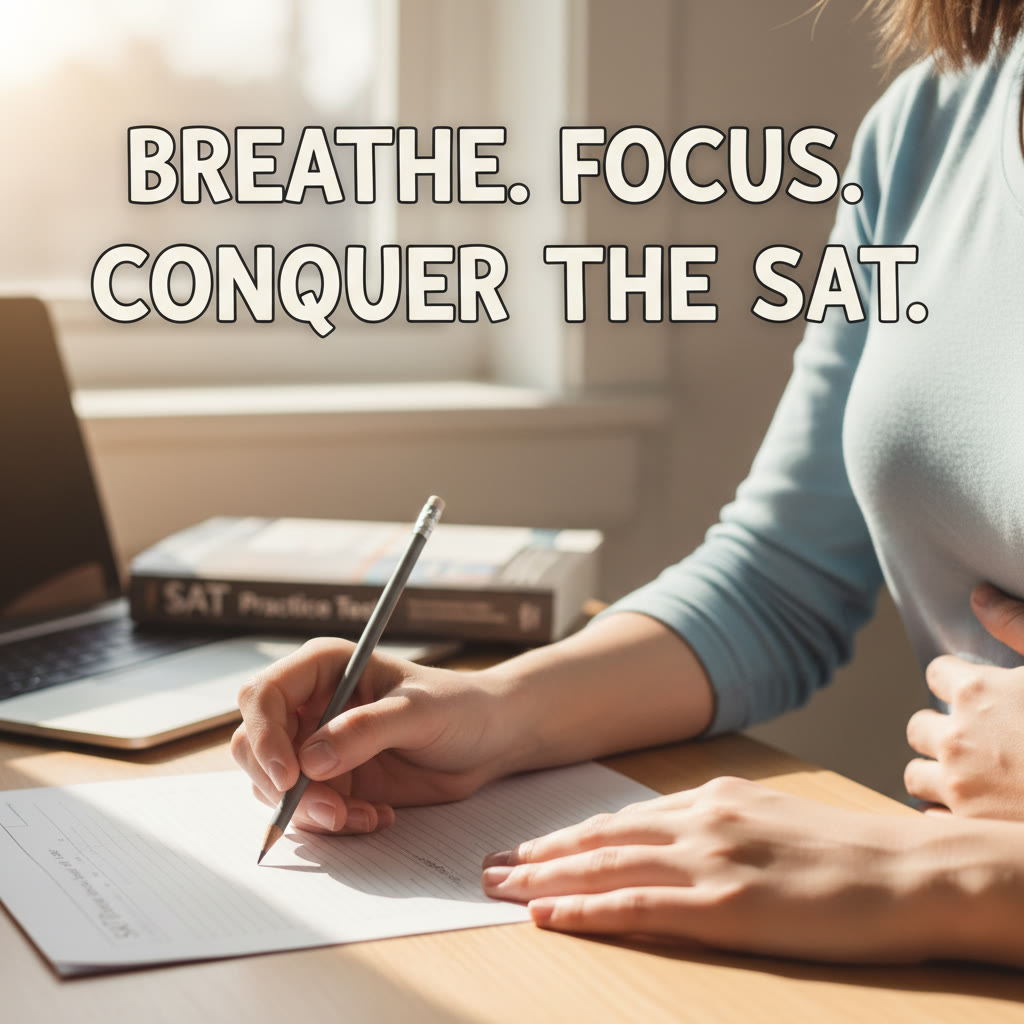How to Use Breathing Exercises Before the SAT: Calm, Focus, and Better Scores
Walk into the test center feeling like your mind is a buzzing swarm of thoughts, and you’re already handicapping your performance. Walk in with five simple breaths and you might find the swarm settling into a single, steady hum. That difference—small, immediate, and entirely under your control—is what breathing exercises offer before the SAT.
Why breathing actually helps (no fluff)
When you feel anxious before a big test, your body flips into “fight-or-flight.” Your heart races, thoughts speed up, and attention narrows in unhelpful ways. Breathing exercises work because breath is the bridge between the automatic body and the thinking mind. Slow, deliberate breathing activates the parasympathetic nervous system, lowering heart rate, reducing cortisol, and improving the brain’s ability to shift attention and hold information in working memory.
In practical terms: calmer body, clearer thinking, better attention to tricky reading passages and multi-step math problems. You don’t need to be a meditation pro to get benefits—just a few minutes of the right breathing patterns can make test-day thinking cleaner and more reliable.
What to expect from a pre-test breathing routine
- Immediate calm: within 1–3 minutes you’ll likely notice slower heart rate and steadier hands.
- Better focus: sustained attention and the ability to move between problems with less anxiety.
- Practical regulation: fewer impulsive answers, improved pacing, and a steadier test-taking rhythm.
Simple, science-backed breathing exercises for SAT day
Below are breathing techniques that are quick to learn, easy to do in the test center, and proven to influence cognitive readiness. I’ll include when to use each one, a short script to follow, and tips for practice.
1. Box breathing (4-4-4-4)
Best for: Settling nerves in a few minutes; use in the morning before arrival or in the waiting room.
- How to do it: Breathe in for 4 counts, hold for 4 counts, breathe out for 4 counts, hold for 4 counts. Repeat 4–6 times.
- Why it works: The hold phases create a momentary pause that interrupts spiraling thoughts; the steady rhythm calms the nervous system.
- Practice tip: Count silently or in your head. Visualize tracing the four sides of a square as you go.
2. 4-7-8 (relaxing breath)
Best for: Deep, quick reset before stepping into the exam room or before a long section.
- How to do it: Inhale for 4 counts, hold for 7 counts, exhale slowly for 8 counts. Repeat 4 times.
- Why it works: Longer exhales stimulate the parasympathetic response, which counters stress and promotes relaxation.
- Practice tip: Keep shoulders relaxed. If 7-count holds feel long at first, start shorter and build up.
3. Diaphragmatic (belly) breathing
Best for: Longer practice sessions during study weeks and for building the habit of steady breathing under pressure.
- How to do it: Place one hand on your chest and the other on your belly. Inhale slowly so the belly rises more than the chest, then exhale fully. Aim for 5–7 breaths per minute for several minutes.
- Why it works: Encourages fuller oxygen exchange, reduces tension in the shoulders, and builds a baseline of calm.
- Practice tip: Do this for five minutes at the end of a study block to simulate test-day composure.
4. Progressive breathing with mindful scanning
Best for: Right before starting the test when you want body and mind check-in.
- How to do it: Combine 3 rounds of slow diaphragmatic breathing with a quick scan: head → neck → shoulders → hands. On each exhale, release any tension you feel.
- Why it works: Addresses both the respiratory rhythm and muscular tension, which is often part of test anxiety.
- Practice tip: Use this routine the morning of the SAT or when you sit down at your desk to begin a practice test.
When to use breathing exercises on test day
Timing matters. Here are practical moments to use breathing so it feels natural, unobtrusive, and effective.
- At home, 15–30 minutes before you leave: a 5–8 minute practice to set the tone for the day.
- In the car or on the bus (if you’re a passenger): 3–5 minutes of box breathing if you’re jittery.
- In the waiting room: a discreet 3–4 minute 4-7-8 routine before you enter the testing room.
- Sitting at your desk before the first section starts: one round of progressive breathing and a 30-second mental scan.
- Between sections: a 60-second reset—one slow inhale, long exhale, shake your shoulders—then return to the page.
A quick 90-second routine you can do at your seat
If the clock is ticking and you have just a minute, this tight reset works well:
- Inhale through your nose for 3 counts.
- Hold for 2 counts.
- Slowly exhale through your mouth for 5 counts.
- Repeat three times. Shake out your hands and place your pencil down and back up to reset your physical rhythm.
How to practice breathing so it works under pressure
Like any SAT skill, reliability comes from practice. You want breathing to be automatic when anxiety strikes. Here’s a simple practice plan you can fold into your SAT prep.
Two-week micro-habit plan (10–15 minutes daily)
Do this on days when you study or take practice tests. The idea is to pair breathing with other study tasks so it becomes a cue-based habit.
- Days 1–3: 5 minutes diaphragmatic breathing after each 50-minute study block.
- Days 4–7: Add a 3-minute box-breathing session before a practice test section.
- Days 8–11: Practice the 4-7-8 routine first thing in the morning and 90-second resets between timed sections in practice tests.
- Days 12–14: Simulate test-day: do morning routine, waiting-room breath, and seat resets during a full-length practice test.
Sample table: Which breathing exercise to use and when
| Exercise | Duration | Best time to use | Main effect |
|---|---|---|---|
| Box breathing (4-4-4-4) | 3–5 minutes | Waiting room, morning prep | Stabilizes heart rate and focus |
| 4-7-8 relaxing breath | 2–4 minutes | Right before seat, between sections | Deep relaxation, quick reset |
| Diaphragmatic breathing | 5–10 minutes | Practice days, morning routine | Improves baseline calm and oxygenation |
| Progressive breathing + scan | 2–5 minutes | Before starting a section | Releases muscle tension and reduces distraction |
Putting breathing into context with SAT preparation
Breathing isn’t a magic pill—you still need content mastery, timed practice, and strategy. Think of breathing as the cognitive tuning before you play your best instrumental piece. In real terms, that means:
- Combine breathing practice with timed practice tests so your calm is connected to the real task of solving problems under time pressure.
- Use breathing to reduce impulsive answering. When you feel the instinct to guess, a two-breath pause often saves you from a careless mistake.
- Pair breathing with targeted study—read actively for comprehension and use breath to reset between difficult reading passages.
How tutors and personalized programs can help
Integrating breathing into your prep is straightforward, but students often benefit from someone who tailors the plan to their rhythm. That’s where programs like Sparkl’s personalized tutoring and benefits can be useful: they provide 1-on-1 guidance to practice breathing around your strengths and weaknesses, create tailored study plans that include mental skills, offer expert tutors who model test-day routines, and use AI-driven insights to pinpoint when you’re most likely to need a reset. If you work with a tutor, ask them to time breathing routines inside full-length practice tests and to coach you on subtle, practical cues for when to use each technique.
Real student examples: small tweaks, big effects
Students often report that breathing helped them in specific, testable ways. Here are a few common scenarios:
- Caleb: He used a 90-second 3-2-5 routine before the Math section and reduced careless sign errors. He called it his “two-breath check.”
- Maya: She had reading-section panic. After practicing diaphragmatic breathing during passages, she stopped losing time on re-reads and increased her Reading score through steadier focus.
- Priya: She combined Sparkl’s personalized tutoring sessions with short breathing breaks. The tutor helped her cue breathing after every 10 questions she completed, which improved pacing and endurance on full-length tests.
Common mistakes and how to avoid them
- Trying complicated routines under pressure: Keep it simple. Your brain won’t add a new step during a stressful moment.
- Ignoring posture: Slouching compresses breathing. Sit tall for full diaphragmatic expansion.
- Over-breathing: Fast, deep breaths can increase anxiety. Aim for controlled, even breaths.
- Skipping practice: Like a sprint start, breathing only helps if it’s a practiced movement.
Practical scripts: words you can say to yourself
Sometimes a short phrase paired with breath is all you need. Here are quick, printable scripts you can memorize:
- Before the test (box breathing): “In—2—3—4, Hold—2—3—4, Out—2—3—4, Hold—2—3—4.” (Repeat 4 times.)
- Seat reset (90-second): “Breathe in three—hold two—out five. Focus on the next question.”
- Between sections: “Release shoulders. In two, out four. Start fresh.”
What to measure so you know it’s working
When you introduce any new test-day habit, track small, objective outcomes:
- Pacing consistency: Do you have fewer sections where you run out of time?
- Careless errors: Do arithmetic mistakes decline after you adopt a breath-check?
- Stress reports: On a 1–10 scale, is your pre-test anxiety number dropping?
- Practice test scores: Look for steadier performance across practice tests rather than isolated spikes.
Putting it all together: a sample morning-of routine
Here’s a simple routine that many students find calming and practical. Adapt times to your schedule.
- Wake up: 10–15 minute gentle diaphragmatic breathing and light stretching (5–8 minutes).
- Breakfast: Keep it balanced. Hydrate. No intense last-minute cramming.
- Before leaving: 3 minutes box breathing to set the mood.
- In waiting room: 2 rounds of 4-7-8 if nerves spike.
- At seat: 90-second reset, scan for tension, and begin the test.
Final tips and encouragement
Breathing exercises are a tool—quiet, portable, and effective when used with practice. They won’t replace studying, but they often magnify the value of the work you’ve already done by giving you a clearer, steadier mind on test day.
Be patient with the process. Spend a few minutes daily building the habit and practice it within real timed sections. If you want personalized accountability and someone to weave breathing routines into your study plan, Sparkl’s personalized tutoring and benefits can help coordinate breathwork with your practice schedule and provide the tailored coaching to make those minutes count.
And remember: the SAT tests what you know and how well you can show up. A few mindful breaths don’t change your knowledge, but they change how well you can access it. Walk in, breathe slow, and do the test you practiced for.



















No Comments
Leave a comment Cancel